Check out these 10 super useful tips for fixing kitchen sink problems in Singapore. Learn how to deal with leaks and clogs so your kitchen stays running smoothly.
Table of Contents
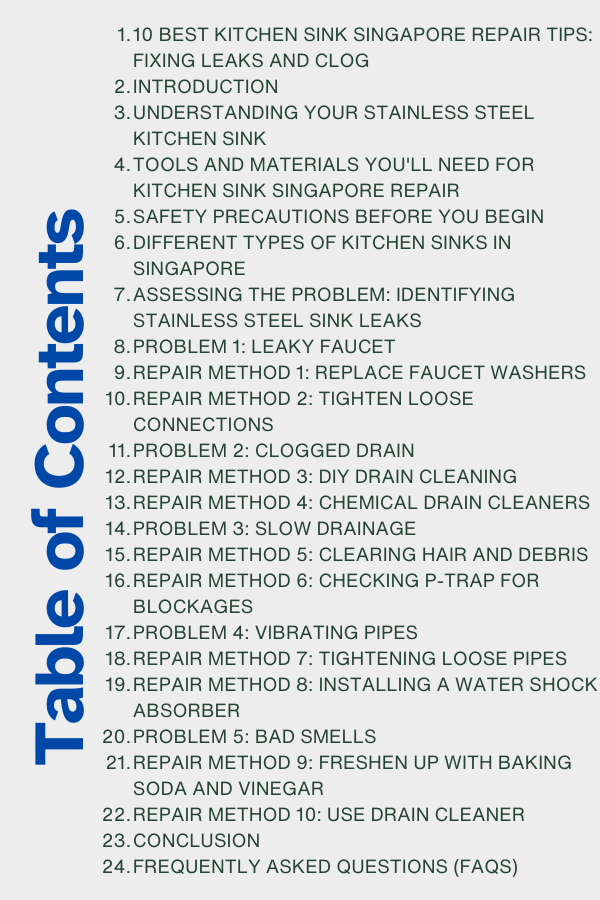
Introduction
Handling frustrating issues in the kitchen can be a hassle for every Singaporean. From the leaking to the stubborn clog, these issues have the potential to affect your everyday routines in the kitchen, can cause big problems if ignored and can even make things worse. As a result, understanding how to address these issues is important to any homeowner. In this comprehensive article, we will discuss the most common problems with the kitchen sink Singapore and provide 10 solutions to each on the DIY trail. By the end of this article, you’ll have a greater sense of confidence in your capacity to address these concerns and ensure the proper functioning of your kitchen.
Understanding Your Stainless Steel Kitchen Sink
The best kitchen sink in Singapore serves as a central fixture in any kitchen, fulfilling multiple roles that are essential for daily activities. Its primary purpose lies in facilitating cleaning and washing tasks, including washing dishes, utensils, and cookware after meals. Its primary function is to facilitate the cleaning and washing of dishes, utensils, and cookware following meals.
Additionally, the perfect kitchen sink Singapore has a significant role in the preparation of food, providing a space to wash fruits, vegetables, and other ingredients before cooking or eating. Beyond its functional attributes, the sink has a role in maintaining the hygienic nature of the kitchen environment, preventing the transmission of bacteria between different foods and ensuring the area surrounding the kitchen is clean.
Additionally, the kitchen sink Singapore functions as a tool to organize, it provides a designated space for dishwashing and utensils, this prevents chaos and maintains order in the kitchen area. With its practical functionality and aesthetic design in the beautiful kitchen, the sink in the kitchen not only increases the efficiency of daily tasks, but also increases the overall beauty of the kitchen, making it an important component of any household.
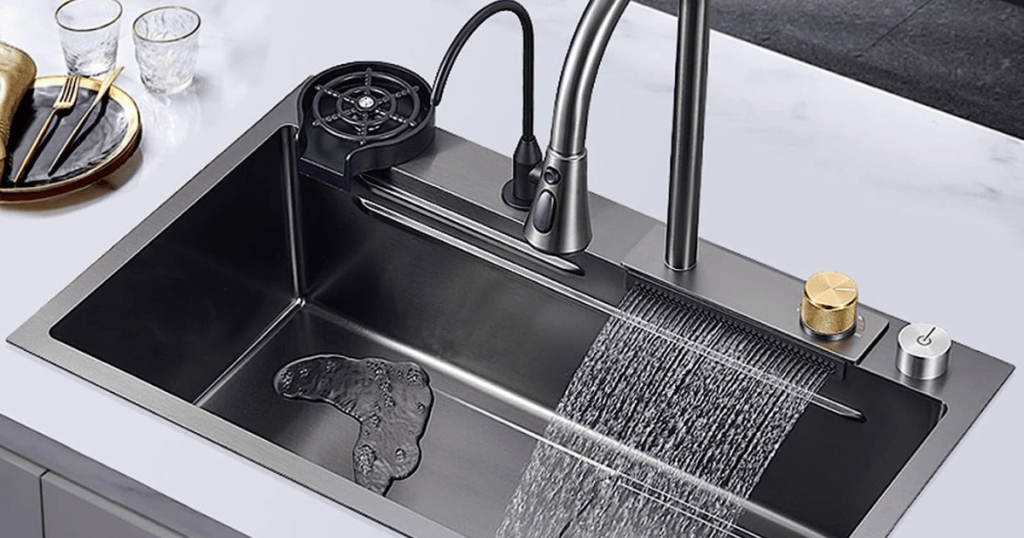
Tools and Materials You’ll Need for Kitchen Sink Singapore Repair
Having the right tools and materials on hand is essential for successful kitchen sink Singapore repairs. Basic tools like wrenches, pliers, and screwdrivers are often needed for various repairs. To get your kitchen sink fixed up right, you’ll need more tools and materials. Here are some specific tools of what you might need:
Plumbers’ Pliers: These can help you grip and turn pipes and fittings securely, making it easier to disassemble and reassemble parts of the sink.
Screwdrivers: Both flathead and Phillips-head screwdrivers may be required for removing screws from various components of the sink.
Plumber’s Tape: Also known as Teflon tape, this is used to seal threaded connections to prevent leaks.
Replacement Washers: Washers often wear out and cause leaks, so having a variety of sizes on hand can be helpful for quick fixes.
Chemical Drain Cleaner: For stubborn clogs, a chemical drain cleaner can help break down blockages and restore proper drainage.
Pipe Wrench: If you need to work on pipes or fittings, a pipe wrench can provide extra leverage to loosen or tighten connections.
Plunger: A plunger is essential for clearing minor clogs in the sink drain
Safety Precautions Before You Begin
Safety should always be your top priority when doing home repairs, especially plumbing and electrical work. Before you start repairing your stainless steel undermount kitchen sink Singapore, be sure to turn off the water supply and, if necessary, the power supply to avoid accidents. Additionally, wear appropriate safety equipment, such as gloves and safety glasses, to protect yourself from potential hazards. Taking these precautions will ensure a safe and successful restoration process of the kitchen sink for your home.
Turn off water and electricity: Before starting any repair work, turn off the water supply to the sink and turn off any nearby outlets or appliances. This prevents the risk of electric shock and minimizes water damage in the event of a leak.
Wear protective gear: Always wear appropriate protective gear, including gloves and safety glasses, to protect your hands and eyes from potential hazards. It is also recommended to wear closed shoes to avoid injury from falling objects or sharp tools.
Use the right tools and equipment: Use the right tools for the job and make sure they are in good condition. Avoid using damaged or worn tools as this increases the risk of an accident. Keep tools neat and easy to use to minimize the possibility of trips and falls.
Work in a place with good airflow: When using chemical drain cleaners or solvents, make sure there’s enough fresh air so you don’t breathe in any bad smells. Open doors and windows or use fans to improve air circulation and reduce exposure to toxic chemicals.
Follow manufacturer’s instructions: When using sink repair tools, materials, or products, carefully read and follow the manufacturer’s instructions. Improper use may cause accidents or damage to sinks and plumbing systems.
Know your limits: While DIY repairs can be cost-effective, know when to seek professional help. If you are unsure about a repair or experience unexpected complications, hire a professional technician SG immediately to avoid possible injury or further damage.
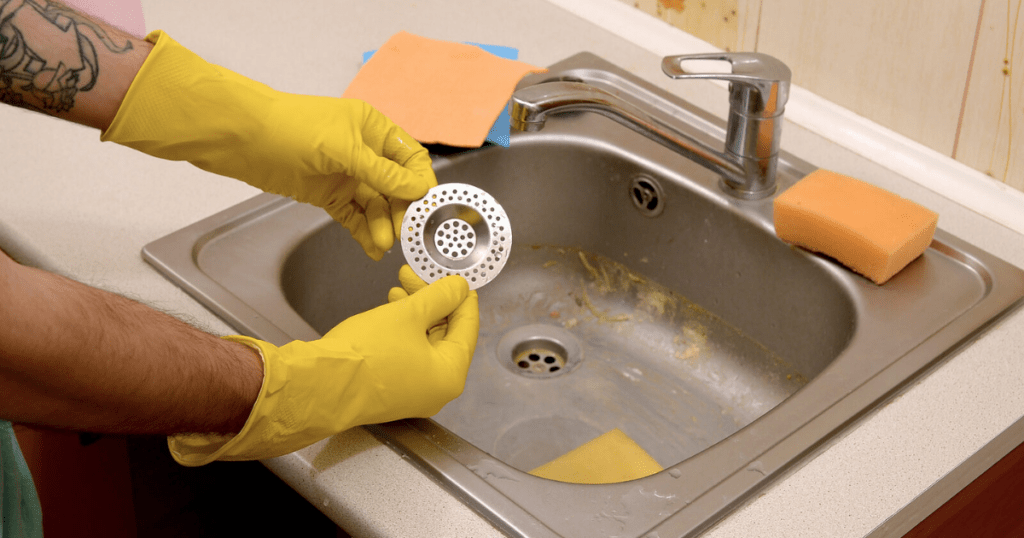
Different Types of Kitchen Sinks in Singapore
With a wide range of stainless steel kitchen sinks available, selecting the perfect one from variety of kitchen sink Singapore can seem daunting. However, by considering your preferences and requirements, you can easily find the perfect fit for your kitchen. When selecting a kitchen sink, explore the variety of options available, including different sizes, styles, and configurations.
Whether you prefer a single bowl or a double bowl sink, or a farmhouse-style or top mount design, there’s a kitchen sink to cater to every taste and functionality requirement. At the same time, understanding different types of kitchen sinks is crucial for knowing how to repair and maintain them. Here’s an introduction to several common types of kitchen sinks found in the market.
Stainless Steel Sinks: Famous for their durability, budget, and ease of maintenance, stainless steel kitchen sink Singapore are resistant to stains, rust, and heat, this makes them suitable for busy kitchens.
Cast Iron Sinks: Providing a traditional, timeless design, cast iron kitchen sink Singapore are remarkably durable. Covered with coating or surface layer, they have additional protection against damage and stain.
Composite Granite Sinks: Composite granite kitchen sink Singapore are crafted from a mixture of granite stone powder and plastic, they have a robust, heat-resistant surface. Different colors and patterns are available, they provide a modern and fashionable option for kitchens.
Fireclay Sinks: With a smooth, non-porous surface that is resistant to staining and scratching, fireclay kitchen sink Singapore are made from clay that is fired to a high temperature. They produce a traditional farmhouse style that is exceptional in durability.
Undermount Sinks: Under the counter, a kitchen sink Singapore hat fits underneath the kitchen counter. have a smooth appearance and allow easy to clean. Discoverable in diverse varieties and styles, they provide a smooth and contemporary appearance to any kitchen.
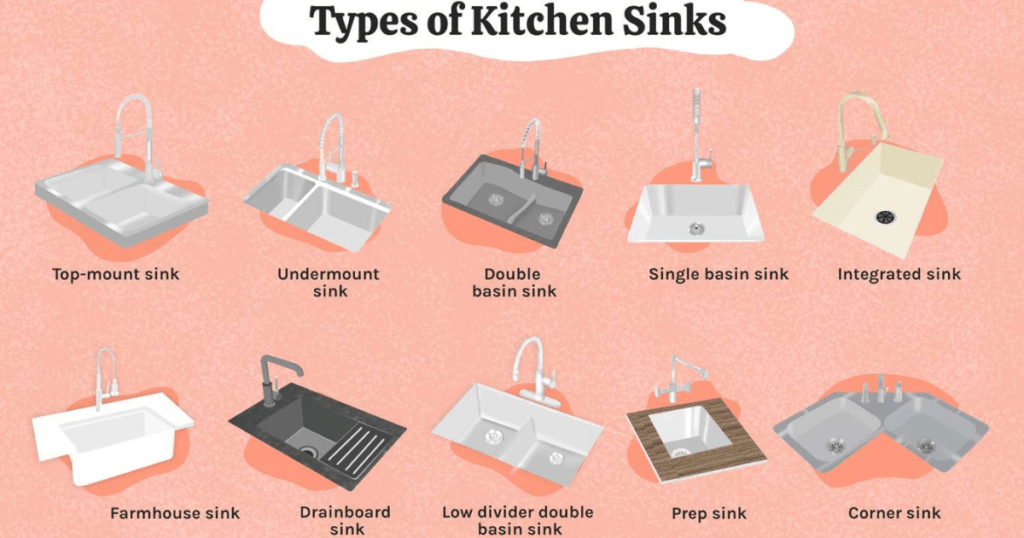
Assessing the Problem: Identifying Stainless Steel Sink Leaks
Leaks are common in the kitchen’s sink area, and if not addressed immediately will cause serious water damage. When evaluating a circumstance like recognizing leaks in your kitchen’s sink, it’s crucial to follow a systematic approach. Here’s how to do it:
Watch for Signs of Leakage: Look for obvious signs of water or moisture near the base of the kitchen faucet Singapore, under the sink cabinet, or along the pipes. Other nearby surfaces may also be affected by water stains or discoloration. This is indicative of a leak.
Inspect the Components of the Faucet: Start by studying the area of the kitchen faucet Singapore. Look for any flaws, rust, or malfunctions in the faucet’s handles and spout. Additionally, you should inspect the faucet’s interior for any cracks or spots. Run water and observe if there are any drips or leaking during the use of the kitchen faucet Singapore.
Examine the supply lines: Next, review the supply lines that connect the faucet to the water supply system. Check for signs of damage, like cracks, bumps, or rust, especially around the connections. Tighten any loose bonds using a wrench if necessary.
Check Drain Pipes: Finally, inspect the clogged drain pipes and fittings under the kitchen sink Singapore. Look for signs of water loss or leaks near the pipes and joints. Tighten any loose connections or replace worn out washers in order to address any problems with leaks.
Use a flashlight: In areas with low lighting, use a flashlight to enhance your visibility. This will facilitate the detection of any concealed leaks or imperfections.
Dry the Area: Before inspected, make sure all wet or damp areas around the sink are dried out to ensure a clean appearance. This will make it easier to spot any hidden leaks or damage.
If you want to learn more about fixing leaks in other areas of your home, check out: “8 Plumbing Hacks for Reliable Plumbing Services in Singapore.”
Problem 1: Leaky Faucet
A leaking faucet not only wastes water but can also drive up your utility bills. Common signs of a leaking faucet include constant dripping or water pooling around the base. One possible cause of leaks is worn-out faucet washers, which can easily be replaced with basic tools and materials.
Repair Method 1: Replace Faucet Washers
To fix a leaking kitchen faucet Singapore, start by turning off the water supply and disassembling the faucet to access the washers. Remove the old washers and replace them with new ones, ensuring a tight seal to prevent future leaks. Be sure to follow manufacturer instructions and use plumber’s tape to secure threads for added protection against leaks.
Repair Method 2: Tighten Loose Connections
First, shut off the water supply before tackling a leaky faucet. Then, take apart the faucet to get to the washers. Swap out the old washers for new ones, making sure they’re snug to prevent more leaks down the line. Stick to the manufacturer’s instructions and use plumber’s tape on the threads to keep everything watertight.
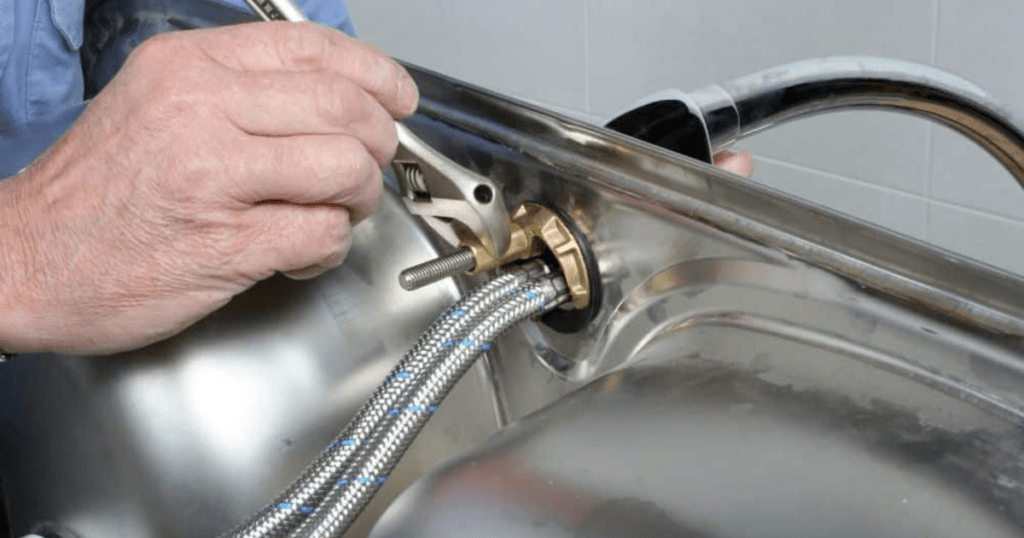
Problem 2: Clogged Drain
A blockage in the drain can be a significant problem, this can lead to water back up and a slow drainage process. Common causes of blockages include food debris, grease, and foreign objects that are embedded in the drain. Fortunately, there are several homemade methods for clearing minor obstacles and restoring proper drainage.
Repair Method 3: DIY Drain Cleaning
For smaller clogs, begin with a plunger that will unclog any obstructions in the drain. Apply pressure to the problem and utilize a pumping motion to create suction and release the obstruction. Alternatively, you can attempt to pour your own DIY cleaning products such as a mixture of hot water and baking soda down the clogged drain in order to loosen the grease and other debris.
Repair Method 4: Chemical Drain Cleaners
If DIY methods fail to clear the clog, chemical drain cleaners can be effective to break down difficult blockages. Select a product that is specifically intended for use in kitchens and follow the instructions of the manufacturer with care. Ensure that you wear gloves and protect your eyes when using chemical drain cleaners, and avoid combining different products that could lead to hazardous results.
Problem 3: Slow Drainage
Slow drainage is often a sign of a partially obstructed drain, this prevents the flow of water through the pipes. Hair, soap scum, and other materials can build up over time that will block the flow of water and lead to backups. By addressing the cause of the slow drainage, you can restore proper water flow and prevent additional problems.
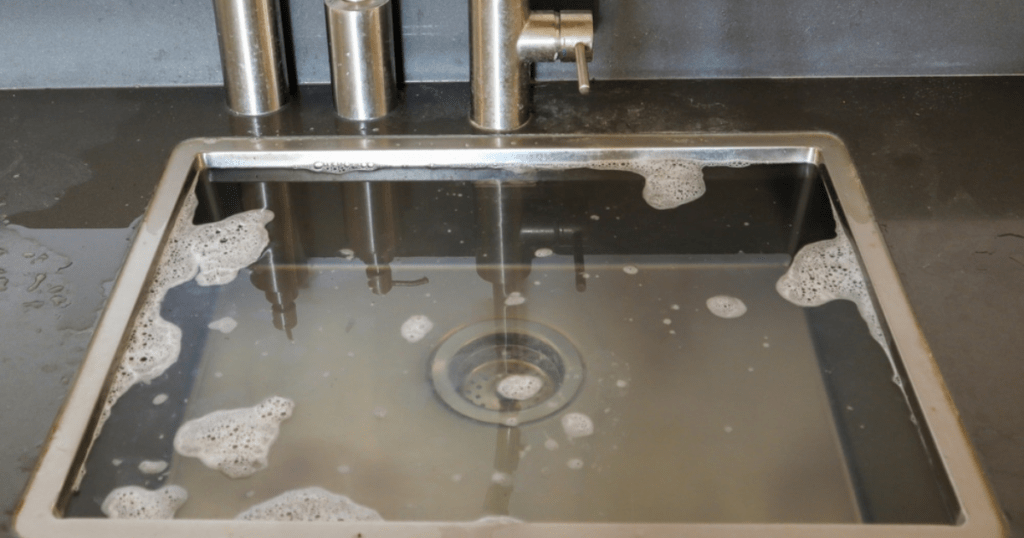
Repair Method 5: Clearing Hair and Debris
Start by removing the drain stopper and clearing any hair or debris trapped in the clogged drain. A pair of needle-nose pliers or a straightened wire hanger can be helpful for reaching and extracting stubborn blockages. For more extensive clogs, consider using a drain snake to break up and remove obstructions from the pipes.
Repair Method 6: Checking P-Trap for Blockages
The P-trap, which is located under the kitchen sink Singapore, is often where debris builds up and blocks things. To inspect the P-trap, place a bucket at the bottom that can catch any water and then carefully take the trap out using a wrench or pliers. Remove any trash and reconfigure the trap, making sure it is sealed properly to prevent leaks.
Problem 4: Vibrating Pipes
When your kitchen pipes vibrate, they make annoying noises that disturb the peace. It’s like having a constant rattling or clanking sound in your home, which can be really irritating. These noises signal that something might be wrong with your plumbing, so it’s important to fix them quickly.
Repair Method 7: Tightening Loose Pipes
Check all pipes under the sink. Use a wrench or pipe clamp to secure loose fittings or connections. This reduces vibration and makes loud pipes quieter. To tighten loose pipes, do the following:
Inspect the Pipes: Take a look at all the pipes under your sink to identify any loose fittings or connections.
Use a Wrench: If you find any loose parts, use a wrench to tighten them. Turn the wrench clockwise to secure the fittings or connections in place.
Secure with Pipe Straps: For pipes that are not easily accessible with a wrench, use pipe straps to secure them. Wrap the pipe strap around the pipe and fasten it securely to the surface using screws.
Test for Tightness: After tightening all the loose pipes, give them a gentle tug to ensure they are secure. This will help reduce vibrations and quiet noisy plumbing in your kitchen.
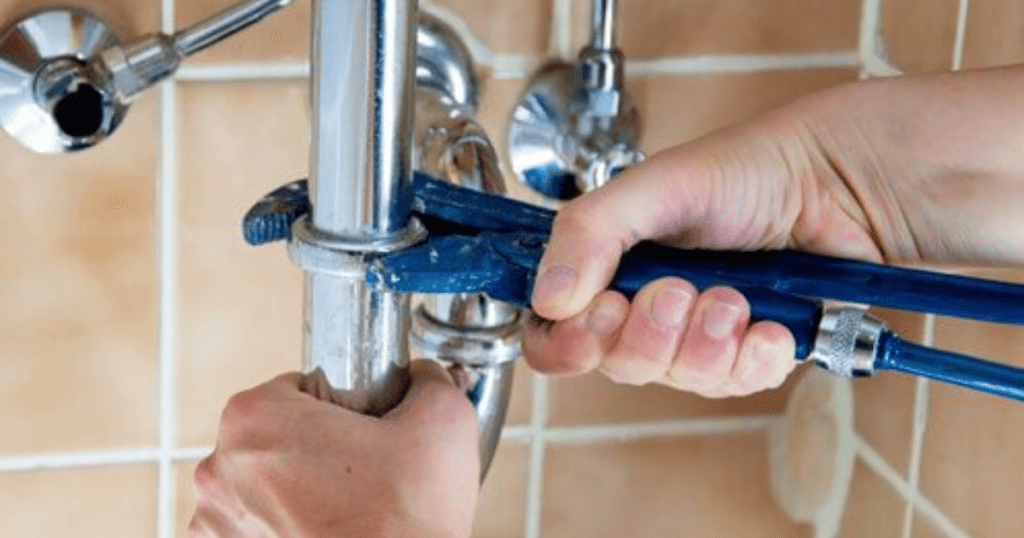
Repair Method 8: Installing a Water Shock Absorber
If you’re dealing with the problem of vibrations in pipes, one effective solution is to place a water shock absorber near the affected area. These specialized devices are intended to absorb the abrupt jolt caused by water motion changes. By completing this, they effectively reduce the vibrations of your system and protect it from any potential harm.
Start by recognizing the area of the pipes that experience the greatest amount of vibrations. This will be the most effective place for installing the water shock absorber. Select a spot that is near the pipes that are vibrating and is easily accessible. This spot will also be near the area of concern. Follow the instructions of the manufacturer regarding the installation of the water shock absorber.
This typically involves attaching it to the wall or floor near the pipes that vibrate. Once it’s installed, assess the effectiveness of the water shock absorber by turning on the water supply and observing if the vibrations have been reduced. If necessary, make alterations to the position of the absorber in order to have the greatest effect. By implementing this solution, you can effectively reduce the vibrations in your pipes, which will lead to a more quiet and consistent plumbing system.

Problem 5: Bad Smells
When your kitchen sink starts to stink, it can completely alter the mood of your cooking. The worst thing you want when cooking your favorite meal is a yucky smell drifting in the air. However, don’t be concerned, there are simple solutions to this problem and you will once again have a fresh, natural scent in your kitchen. Let’s discuss some simple solutions to address the bad smells.
Repair Method 9: Freshen Up with Baking Soda and Vinegar
If you find the smells in your kitchen’s sink unacceptable, don’t worry. There’s a simple answer using baking soda and vinegar. Just combine the same amounts of each and pour it out through the clogged drain. Allow it to sit for approximately 30 minutes. This magical mixture will dissociate any toxic chemicals that cause the odor. After that, pour hot water through the clogged drain to eliminate any remaining debris. This simple method will remove the scent in your kitchen’s sink.
Repair Method 10: Use Drain Cleaner
There’s a simple solution to that annoying kitchen sink smell: try a drain cleaner. Find a product that can remove odors and eliminates dirt. Just follow the directions on the bottle for best results. This is a quick and easy way to get your kitchen sink smelling fresh again.
Conclusion
In conclusion, problems with the kitchen’s sink are common, but they can be addressed with the proper knowledge and tools. By understanding the different components of your sink and learning about the common problems and repair methods, you can address minor issues with confidence and keep your kitchen running smoothly. Remember to focus on safety, follow the manufacturer’s instructions, and seek professional assistance for difficult issues. With a bit of effort and knowledge, you can maintain a functional and leak-free kitchen sink for the long haul.
FAQs (Frequently Ask Question)
How much does it cost to fix a kitchen sink?
The cost to repair a kitchen sink Singapore can vary depending on the problem and the plumber’s rate. Repairs for common problems such as leaks or blockages can cost between S$50 and S$200. For more complex problems or replacements, the cost may be higher.
How much does a kitchen sink cost in Singapore?
The cost of kitchen sinks Singapore can vary depending on factors such as material, size and brand. Generally speaking, stainless steel sinks are cheaper, ranging from S$100 to S$500, while granite or quartz sinks may cost between S$300 to S$1,000 or more. Explore the different options to find one that suits your budget and preferences.
Do plumbers work on kitchen sinks?
Yes, plumbers are trained to work on all types of plumbing fixtures, including kitchen sinks. Whether it’s fixing a leak, clearing a clogged drain, or installing a new kitchen faucet Singapore, plumbers have the expertise to effectively solve kitchen sink Singapore problems.
How do I unclog my kitchen sink Singapore?
If you are facing a clogged kitchen sink problem in Singapore, here are a few things you can try. First, clear the clogged drain of any visible debris or food particles. Then try using the plunger to create suction to loosen the clog. If that doesn’t work, consider using a drain cleaner specifically designed for kitchen sink Singapore.
How do you unclog an aircon pipe?
To unclog an aircon pipe, you can start by turning off the air conditioner to prevent further water leakage. Then, locate the condensate drain line, which is typically found near the outdoor unit. Using a wet/dry vacuum or a simple wire brush, carefully remove any debris or buildup blocking the drain line. Alternatively, you can mix equal parts of vinegar and water and pour it down the drain line to dissolve any algae or mold buildup. If the clog persists, it’s best to contact a professional technician. If you’re looking for the best aircon service provider Singapore can consider contacting SibehCool aircon service Singapore technician for assistance.


